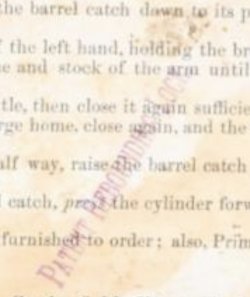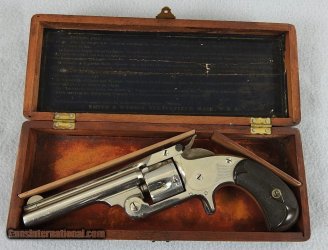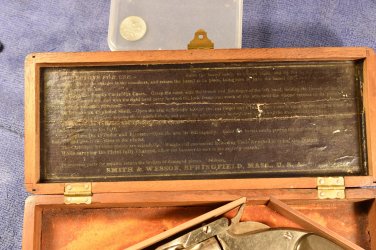ClickBang!
Member
- Joined
- May 9, 2025
- Messages
- 32
- Reaction score
- 20
Hi All,
I have seen several posts (here and elsewhere) about rebounding hammers on older S&W breaktops. However, looking at the interior of an old box lid for .32 1 1/2 DA breaktop, I see these instructions:
"While Carrying the Pistol fully Charged, allow the hammer to rest in the safety catch. After the first discharge, allow the hammer to rest on the exploded cartridge until the next discharge, and so on until all are fired."
It's interesting to me - nothing in these original S&W box instructions suggest that there is an automatic rebounding hammer mechanism on these revolvers. "Allow the hammer" seems to imply that the user must either a) cause it to occur or b) not manually override it. What immediately comes to mind is the old H&R Model 1900 single shot exposed hammer shotgun. Those had a true rebounding hammer that you could not override. Upon pulling back the hammer and firing, the hammer would automatically rebound. Once you released the trigger fully, there was no option to reset or "allow" the hammer to rest on a spent case. It had already rebounded.
Based on the box lid instructions, it seems like allowing the hammer to rest on the spent case was a safety feature of sorts. However, this would be impossible if the hammer rebounded off of the spent case primer, right? I know that it's possible to manually move a 1 1/2 CF revolver into a "1/8th cock" if you will, manually - and this seems to be the "safety catch" the original box instructions are referring to. Am I missing something here?
I have seen several posts (here and elsewhere) about rebounding hammers on older S&W breaktops. However, looking at the interior of an old box lid for .32 1 1/2 DA breaktop, I see these instructions:
"While Carrying the Pistol fully Charged, allow the hammer to rest in the safety catch. After the first discharge, allow the hammer to rest on the exploded cartridge until the next discharge, and so on until all are fired."
It's interesting to me - nothing in these original S&W box instructions suggest that there is an automatic rebounding hammer mechanism on these revolvers. "Allow the hammer" seems to imply that the user must either a) cause it to occur or b) not manually override it. What immediately comes to mind is the old H&R Model 1900 single shot exposed hammer shotgun. Those had a true rebounding hammer that you could not override. Upon pulling back the hammer and firing, the hammer would automatically rebound. Once you released the trigger fully, there was no option to reset or "allow" the hammer to rest on a spent case. It had already rebounded.
Based on the box lid instructions, it seems like allowing the hammer to rest on the spent case was a safety feature of sorts. However, this would be impossible if the hammer rebounded off of the spent case primer, right? I know that it's possible to manually move a 1 1/2 CF revolver into a "1/8th cock" if you will, manually - and this seems to be the "safety catch" the original box instructions are referring to. Am I missing something here?










